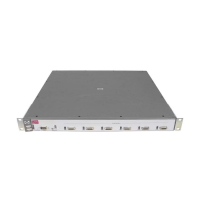PIM-DM (Dense Mode) on the 5300xl Switches
Troubleshooting
Troubleshooting
Symptom: Noticeable slowdown in some multicast traffic. If the
switch is supporting more than 1022 active flows. This generates the message
Unable to learn HW IP multicast groups, table FULL in the
Event Log because there is no room in the hardware Multicast Routing Table
to add another Multicast Group. Software will route any multicast packets
sent to multicast groups that are not in the hardware Multicast Routing Table,
but it will be slower and packets may be dropped if the data rate is greater
than 3000 packets per second. Refer to
“Flow Capacity” on page 5-35.
Note that the PIM protocol uses one MRT entry for every IP multicast source/
group pair that it is routing. An entry is not used if the multicast flow is bridged
and not routed. Entries in this table are automatically aged out if they are
unused for a period of time.
Heavy Memory Usage. Heavy use of PIM (many S/G flows over many
VLANs) combined with other memory-intensive features, can oversubscribe
memory resources and impact overall performance. If available memory is
exceeded, the switch drops any new multicast flows and generates appropri-
ate Event Log messages. Corrective actions can include reducing the number
of VLANs on the 5300xl switch by moving some VLANs to another device, free
up system resources by disabling another, non-PIM feature, and/or moving
some hosts to another device. For more information, refer to
“Operating
Notes” on page 5-34 and “Messages Related to PIM Operation” on page 5-37.
IPv4 Table Operation. The IPv4 table, which contains the active IP multi-
cast addresses the switch is currently supporting, has 128k entries. However,
the IPv4 table also contains IP host entries for every IP source or destination
that the switch has learned, as well as ACL flow entries. Entries in this table
are generally aged out if they are unused for 5 minutes or more.
5-36

